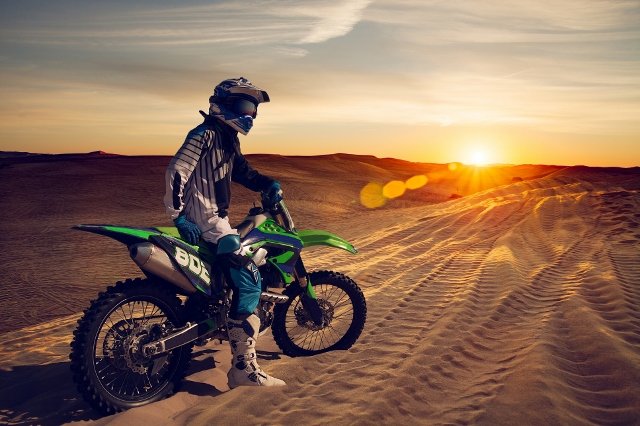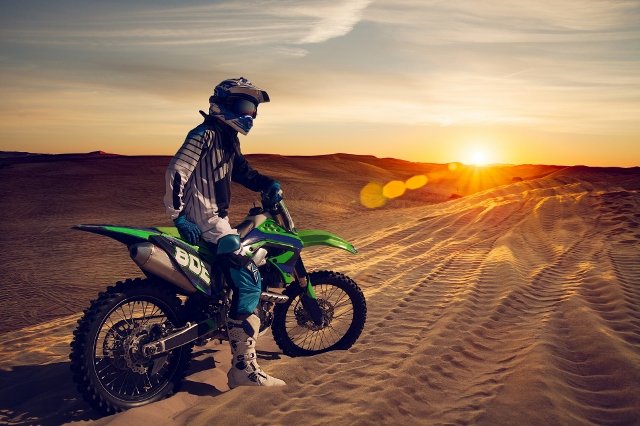
It’s a more common scenario than many imagine: a dirt bike, a desert breakdown or accident. If you’re prepared for a worst-case scenario, you can survive the harsh conditions the desert delivers – as long as you don’t panic. Stay calm and consider your options, then decide on a reasonable plan.
Take stock of your kit, such as those offered by ATV, SxS and dirt bike delears. If you can’t make a necessary repair to the bike or manage to ride out due to injury, think it through and get your survival priorities in order. Preparation is key and the difference between an uncomfortable experience and a fight for survival. Here are five essentials that will get you out alive:
1. Water
Water is your most essential need. Many desert riders carry extra water and tote along simple emergency provisions like Gatorade and Power Bars. You may have to tough it out and ration supplies, but if you have enough water to stay hydrated your survival chances are good. What should you ration? Your sweat! Find shade or shelter and limit activities to cooler nights. Don’t sip – when you need a drink, take a good one so the brain and vital organs realize they’re being hydrated. If there’s natural water nearby you should be able to spot it by taking note of greener vegetation, flights of birds and the path of animal tracks. Digging along the banks of dry creek beds may yield some water. Are you carrying some form of water purification device? Use it when drinking any water you find.
2. Fire
It might seem strange to some that fire is a survival essential in a hot, arid environment. But a fire can be used as a signal, to purify water and cook food, and will be especially welcome when night falls, temperatures drop, and the complete darkness makes an alien landscape more frightening. A good fire will also keep animals at bay, and while there are very few large animals that are dangerous to humans in the desert, it’s comforting to know how to keep them away as night descends. Don’t underestimate this psychological comfort!
3. Shelter
With the right supplies you can turn a nightmare into an impromptu camping trip. A light poncho can double as a rain shelter or improvised tent, and a space blanket is easy to carry on the bike – unfolded, it provides warmth at night and protection from wind and blowing sand. The reflective surface bounces heat away during the heat of day, and dew (moisture = water) may gather on it overnight. White clothing reflects sunlight and also reflects the heat back at your body. Black absorbs your body heat and is the better choice. It’s important to keep skin temperature under 92 degrees to avoid sweating away precious water. You’ll need shelter, so scout out a location that’s visible to searchers. A good option is to drape material (your space blanket or a sleeping bag) over a bush for shade, allowing for cooling breezes. Don’t sit on the hot ground: the body absorbs too much heat through this contact. Avoid sheltering in risky areas like dry creek beds that might flash flood.
4. Signals
The primary thing to remember about signaling for help is that the signal must be easily distinguishable from nature sights and sounds. In sun-drenched desert terrain a signal mirror is visible for miles. Burning a tire sends up a huge column of black smoke, but puncture the tire first or remove the valve core to keep it from exploding and causing a serious injury. Yelling is a waste of time and the effort is exhausting. A whistle is an excellent emergency item that can draw searchers closer, and has the added advantages of scaring away wildlife. Use the whistle in bursts of three. One long whistle can sound like a hawk or airborne predator from the distance, while three short blasts are more clearly a call for help.
5. Food
The human body can survive much longer without food than it can deprived of water. Don’t think of survival in terms of having enough food, because in truth, if your water supply is limited you should eat as little as possible. The process of digesting food depletes the water in your body. This is an uncomfortable reality and you’ll initially feel hungry, but most healthy people can survive for up to three weeks without eating. If you have enough water, still eat sparingly to preserve your body’s hydration level.
Photo caption: Motocross rider at sunset in desert dunes. Getty Images








